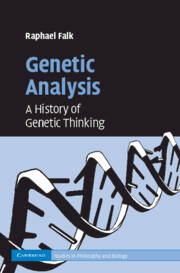Book contents
- Frontmatter
- Contents
- List of figures
- Acknowledgments
- Introduction
- PART I FROM REPRODUCTION AND GENERATION TO HEREDITY
- PART II FAKTOREN IN SEARCH OF MEANING
- PART III THE CHROMOSOME THEORY OF INHERITANCE
- PART IV GENES AS THE ATOMS OF HEREDITY
- PART V INCREASING RESOLVING POWER
- PART VI DEDUCING GENES FROM TRAITS, INDUCING TRAITS FROM GENES
- PART VII WHAT IS TRUE FOR E. COLI IS NOT TRUE FOR THE ELEPHANT
- Concluding comments
- Bibliography
- Index
PART IV - GENES AS THE ATOMS OF HEREDITY
Published online by Cambridge University Press: 07 August 2009
- Frontmatter
- Contents
- List of figures
- Acknowledgments
- Introduction
- PART I FROM REPRODUCTION AND GENERATION TO HEREDITY
- PART II FAKTOREN IN SEARCH OF MEANING
- PART III THE CHROMOSOME THEORY OF INHERITANCE
- PART IV GENES AS THE ATOMS OF HEREDITY
- PART V INCREASING RESOLVING POWER
- PART VI DEDUCING GENES FROM TRAITS, INDUCING TRAITS FROM GENES
- PART VII WHAT IS TRUE FOR E. COLI IS NOT TRUE FOR THE ELEPHANT
- Concluding comments
- Bibliography
- Index
Summary
I think what interested me most in the history of science is the relationship between ideas held at different times, couched in similar terms, yet obviously having different contents and meaning. The view of matter as composed of elementary corpuscles, atoms, preceded by two millennia the development of atomic history. What, if anything, does the second concept owe to the first? How, if not derived from the first, did the second arise?
Dunn (1965, xvii)A century ago, “genes” endowed with the instrumental reductionist status of the Mendelian Faktoren were introduced to overcome the notion of the unit character. The gene was an empiric, functionally defined entity. For Johannsen, gene was a word derived from genotype that should express “only the simple imaging” that “through ‘something’ in the gametes a property of the developing organism is conditioned or is, or could be co-determined” (Johannsen, 1909, 124).
Yet, the meaning of the gene, whether as an intervening variable, a heuristic device for the study of inheritance, or a hypothetical construct, an entity in the physico-chemical world, and what kind of such an entity, became a major issue of genetic analysis. From Richard Goldschmidt's “physiological” perspective genes were merely centers of gravity along the integral units of the chromosome. For Hermann Muller genes were discrete structural entities along the chromosomes. Others, like East, Morgan, and Stadler adopted an operational approach of “instrumental reductionism” (Falk, 1986, 141).
- Type
- Chapter
- Information
- Genetic AnalysisA History of Genetic Thinking, pp. 125 - 127Publisher: Cambridge University PressPrint publication year: 2009



